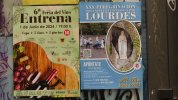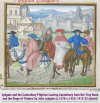The interesting thing to me, as a modern day pilgrim, is that these medieval pilgrims rode on horseback. Nowadays, purists believe that you should walk every step of the way to Santiago de Compostela. In the Middle Ages, the mode of transport was not important. You just had to get there!
Most modern pilgrimages are agnostic as to the means of transportation, and when I say "most", that's actually the
vast majority of them.
Without even considering the many non-Christian pilgrimage destinations in the world, most Christian pilgrims travel by coach or by train in groups with their parish or diocese, or in smaller self-organised groups, family and/or friends. Our local 1st May Marian Pilgrimage to Notre Dame de Laghet gathers hundreds of pilgrims, some going up by coach, most by private car, some on foot.
I'm no longer sure of the stats at Compostela itself, as the numbers of foot/bike/horse pilgrims going there via the Camino has grown massively over the past ten years, but a decade ago and longer the non-Camino pilgrims to Santiago were clearly the majority of pilgrims ; and even in the 2020s, foot pilgrims are a minority of people in the Pilgrim Masses at the Cathedral.
Even just in Spain, I believe that more make a pilgrimage to Montserrat in any year year than to Santiago, and Nuestra Señora del Pilar in Zaragoza, the other major Jacobean pilgrimage destination, has pilgrim numbers comparable to those at Santiago.
What's peculiar about Santiago is its strong tradition of
foot pilgrimages as a major proportion of travels to it, something it shares with the other major Christian pilgrimages only in the pilgrimages to Jerusalem and Fátima. Of course all of the pilgrimage destinations both East and West have some degree of foot pilgrimage, from the smaller and most local ones to the most major of them. But as to the pilgrimage to Rome for instance, whilst there is a huge network of Via Romea foot pilgrimage routes throughout Europe, exactly comparable to the Camino, as to the Roman pilgrimage itself the means of travel there is completely irrelevant, except for one's own personal reasons.
The Way of Saint James to Santiago de Compostela is greatly exceptional in this regard in comparison to Christian Pilgrimages in general.

























